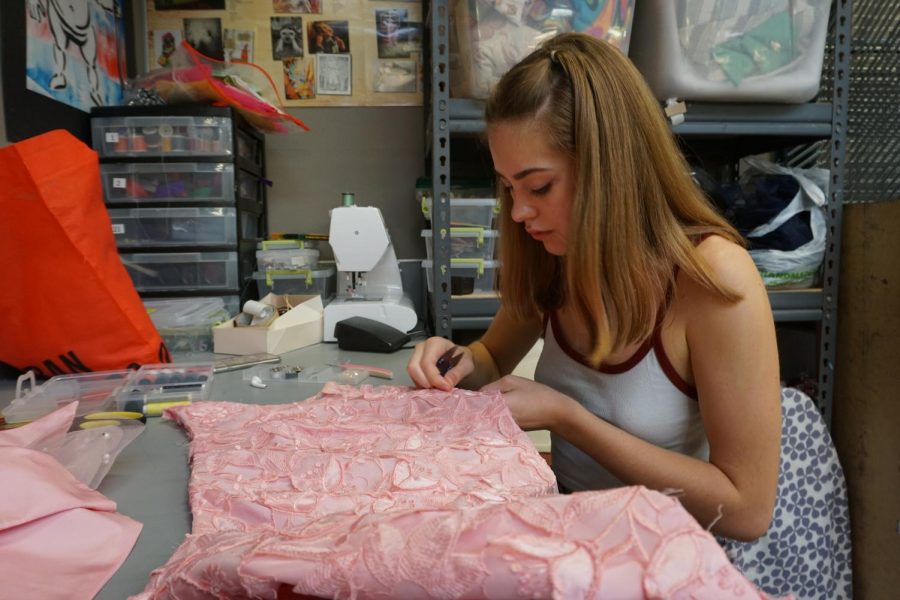For junior, sewing soothes the soul
Designer Pearl Heinley continues to focus on the technical, striving for ‘ultimate perfection’
SOMETHING OLD: Heinley redesigns her mother’s old prom dress to make it into something new and something that is her own. She works during her second-period textiles class of one, in a class that is blended with a Printmaking I class. “My goal is just to improve my skills and work until I make the perfect article of clothing, the perfect technical piece,” Heinley said. Photo by Ellen Fox.
December 6, 2019
The Shield: How would you describe your interest in fashion?
Pearl Heinley: I focus on the technical aspects a lot, so how things are made and how well I can make them. I try to make everything to my standard, which is ultimate perfection, which isn’t very artistic … so my goal is to just improve my skills and work until I make the perfect article of clothing, the perfect technical piece.
TS: What would be something perfect?
PH: The closest I’ve gotten was last spring, I made a prom dress for one of the girls on my swim team, and it turned out really well. It had boning, and bra cups and all this different fabric, and it was really nice. But it wasn’t perfect, I had to re-sew a couple things, and there were some pleats that didn’t quite fit right, and it pulled, and I was just like, ‘It’s OK, but it’s not perfect.’ I think that’s the closest I’ve gotten, but it’s just the little things like that that I want to avoid… It’s a goal that is not attainable, which is why I can always strive for it. If I’m striving for it, I’ll always produce my best work.
TS: Does that inspire a lot of your work ethic?
PH: It does. I start with a technical look, like let’s say I wanted to make a suit jacket. Then I go through and think about ‘OK, Do I want buttons? And how would those buttons fit onto the cuff, and if I was going to add the buttons at what step of the process would I do that?’ so that I don’t have to undo it all and then do it again.
TS: What inspired you to start designing?
PH: Well I’ve been sewing since I was 7 with a machine: I still sew on the machine; it’s really small and has Hello Kitty on it. I love it so much. But I guess it started when I was making a costume for myself for Cinderella. I wanted to be her for Halloween, and then later I wanted to make a costume corset, because I was going to the Ren Fest. So I used that same pattern from the bodice of the dress, and I started modifying the pattern. I would just follow the directions the same and pretend like it didn’t have straps. It turned out pretty OK; it’s not a bad piece, I still have it. But that’s kind of where it all started, with modifying really simple patterns by taking the straps off or raising the hem or adding pockets and then gradually I changed to wanting to change the neckline or adding a third panel and then eventually it gets to ‘Oh, I’m just drafting my own pattern.’
TS: Do you ever wear pieces you make to school or in your everyday life?
PH: I made this black skirt; it’s just a black miniskirt, and I wear it all the time because, you know, it’s a black miniskirt, so it goes with everything.
TS: How do you feel when you make a piece yourself and it turns out well?
PH: It’s a sense of pride, heavy pride. I have another miniskirt: it’s orange, and I would wear it to all these family events, so my aunt or something would come up to me and tell me she liked it, so I could tell her I made it myself. And with me I start with the technical and work at it until I’m proud of it, and I want it to be recognized.
TS: Let’s talk a little bit about the fashion show. So last year as a sophomore you got second place, can you talk a little bit about your line?
PH: It was called the Grand Dame because it was about this idea of excessive extravagance. She is this older woman, maybe in her ’70s, and she’s just kick-ass and doesn’t care what anybody thinks:“I’m going to wear whatever I want all the time.” She wears green and glitter, and it’s big, and she has big glasses and hats just some of that cooky grandma that is ridiculously wealthy. That was the woman I ran with, and I was really happy with that line. I think it was some of the most cohesive clothing I’ve ever produced. It came down to large jackets and satins and detail work, and I’m very proud of that and where I got to, second place, although sometimes I think that it maybe didn’t deserve that. Looking at my line now, I flipped the hem and I was like “this is so ugly.” I saw it and I practically vomited in my mouth a little but because I was in shock, but hopefully this year it won’t be like that.
TS: It’s really cool that you can look at your past work that was obviously so successful and still see areas to make improvements on it.
PH: Yeah, I’ve had to fight the urge to rip apart this one dress: it’s green, it’s got tassels on it, and it looks nice on the outside, but underneath it’s just so ugly. I don’t like looking at it sometimes because it’s just not there yet. And I know I have to just let it be a moment in time.
TS: So what’s your goal for this year?
PH: This year, I’ve got a collection of little ceramic teapots that I want to make a print out of, and use that as an anchor for the line. I’ll be working with, of course, construction, and modifying classic silhouettes to be more modern, like the suit jacket, and playing with not really gender roles, but pieces that anybody can wear, not really one-size-fits-all but more one-style-fits-a-lot. That’s what I’m going with because I’m trying to sell this line. I’m going to show it hopefully in February at Fashion x Austin, which is another fashion show for local designers. I hope to sell that by March or May, to start producing some of that and then add it to my portfolio, so that I can show people that I can not only sell it but that people want to buy it. So that’s the ultimate goal, but the goal for this year for the fashion show it to have a good time and to produce good materials.
TS: Why teapots?
PH: Both of my grandmothers collect small things, and I love tea and my own tiny teacup collection. I see it as my own little collection of “art.”
TS: How does fashion impact your life or other aspects of your life?
PH: It’s a neat fascination for me because it reflects exactly what’s going on in the culture. Right now we’re seeing a big revival in vintage fashion, and a little bit in sustainable fashion, which is a win-lose because thrifting is great, but it doesn’t mean that bigger companies stop producing all this crazy wastewater. Sustainability is such an important goal, and I’m very glad that a lot of fashion is moving towards it, but there are fads with everything. Sustainability may be a fad, body inclusivity and gender inclusivity could be a fad; in 10 years we may not see that in fashion anymore because of the climate. It’s just that fashion is such a good reflection and parallel of society because you can see exactly what the consumer wants. I think at the GUCCI show they were playing with mental health visibility, and it didn’t really go well. There was a duality in the response, but the line still reflects what people are thinking and starting a conversation which is what art does.
TS: In the future, what is your biggest fashion dream or goal?
PH: I want to say it’s to produce or to have my own business, but it’s really not. It’s more that I would want to work for a larger company, maybe like in marketing or textile design. My goal is very broad. I want to survive in the fashion world for as long as possible and sustain myself for as long as possible. I just love that world, I like being around the people. And I know that I can always still sew stuff for myself even if it’s not part of my job, I can still do that myself and take that as my hobby and make myself happy. That’s why I started sewing, because it was such a soothing thing, It’s just so nice, you run it and it’s so meditative because you don’t have to think all the way about it, and you can check out a part of your brain and do some manual labor. So even if I don’t end up as the designer for Dior or anything like that, I can still be happy.
—interview by Ellen Fox

GRAND OL’ TIME: As a sophomore designer, Heinley presents her line, the Grand Dame, to an applauding audience at Paradigm, the 2019 Benefit Fashion Show, in the MAC on Jan. 12. Her line won second place. “It was called the Grand Dame because it was about this idea of excessive extravagance,” Heinley said. “She’s just kickass and doesn’t care what anybody thinks: ‘I’m going to wear whatever I want all the time.’” Photo by Gregory James.




